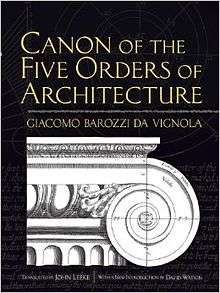The Five Orders of Architecture
 Modern English language cover | |
| Author | Giacomo Barozzi da Vignola |
|---|---|
| Original title | Regola delle cinque ordini d'architettura |
| Country | Italy |
| Language | Italian |
| Subject | Classical architecture |
| Genre | Non-fiction |
Publication date | 1562 |
The Five Orders of Architecture (Regola delle cinque ordini d'architettura) is a book on classical architecture by Giacomo Barozzi da Vignola from 1562, and is considered "one of the most successful architectural textbooks ever written",[1] despite having no text apart from the notes and the introduction.[2] Originally published in Italian as Regola delli cinque ordini d'architettura, it has been fully or partially translated in English with different titles, including Canon of the Five Orders of Architecture; Rules of the Five Orders of Architecture; Vignola: an elementary treatise on architecture comprising the complete study of the five orders, with indication of their shadows and the first principles of construction; The Five Orders of Architecture according to Giacomo Barozzio of Vignola, to Which are Added the Greek Orders; and The five orders of architecture, the casting of shadows and the first principles of construction based on the system of Vignola.
Contents
The book tackles the five orders, Tuscan, Doric, Ionic, Corinthian, and Composite in separate sections, each subdivided in five parts on the colonnade, arcade, arcade with pedestal, individual pedestals, and entablatures and capitals. Following those 25 sections were some less related parts on cornices and other elements. Written during the 1550s, it was published in 1562, and was soon considered the most practical work for the application of the five orders. Apart from the introduction, the book existed solely of 32 annotated plates, with views from the Pantheon illustrating the Corinthian order and the Theatre of Marcellus for the Doric order. Later editions had more illustrations.
Author
Vignola was an Italian Renaissance architect who was the assistant of Michelangelo during his work on the St. Peter's Basilica. He was also one of the architects of the Palazzo Farnese and the Church of the Gesu. Following the examples of the Classical Roman work of Vitruvius and the five books of the Regole generali d'architettura by Sebastiano Serlio from 1537 on, Vignola started writing an architecture rule book on the classical orders. His work was more practical than the preceding two books which were more philosophical in nature.[3]
Editions and translations
It was over the next centuries often reprinted, translated, and used as an inspiration, e.g. for William Robert Ware's main work The American Vignola from 1904. By 1700, it had been reprinted 15 times in Italian, and was translated in Dutch, English, French, German, Russian and Spanish.[4] By the end of the twentieth century, more than 250 editions of the book had been published,[1] marking it as "the most widely used architectural textbook of all up to the nineteenth century [...] forming one of the universal bases of courses of architecture"[5]
Gallery
 Titlepage of the book
Titlepage of the book The five orders, plate I of the Five Orders.
The five orders, plate I of the Five Orders. The Doric Order, plate XII of the Five Orders.
The Doric Order, plate XII of the Five Orders. The Ionic order
The Ionic order The Corinthian Order
The Corinthian Order The Tuscan order
The Tuscan order The capital of a Composite Order column, plate XXVIII of the Five Orders.
The capital of a Composite Order column, plate XXVIII of the Five Orders.
Notes
- 1 2 Evers, Vernd (2003). Architectural theory: from the Renaissance to the present. Taschen. p. 845. ISBN 978-3-8228-1699-8.
- ↑ Summerson, John (1963). The classical language of architecture. MIT Press. p. 56. ISBN 978-0-262-69012-6.
- ↑ Mallgrave, Harry Francis (2005). An Anthology from Vitruvius to 1870. Wiley-Blackwell. p. 590. ISBN 978-1-4051-0258-2.
- ↑ Ware, William R. (1994). The American Vignola: a guide to the making of classical architecture. Courier Dover Publications. p. 160. ISBN 978-0-486-28310-4.
- ↑ Kruft, Hanno-Walter (2003). A history of architectural theory: from Vitruvius to the present. Princeton Architectural Press. p. 706. ISBN 978-1-56898-010-2.
External links
Bibliography and works on line on the "Architectura" website (Centre d'études supérieures de la Renaissance, Tours): http://architectura.cesr.univ-tours.fr/Traite/Auteur/Vignole.asp?param=en
![]() Media related to The Five Orders of Architecture at Wikimedia Commons
Media related to The Five Orders of Architecture at Wikimedia Commons